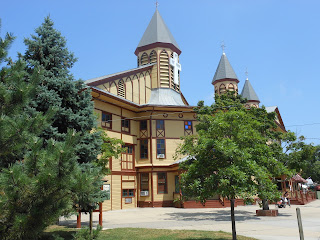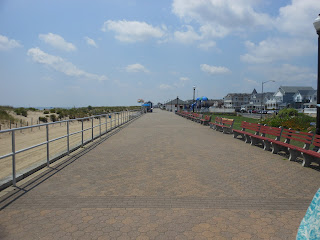Asbury Park, New Jersey is one of
the larger towns on the Jersey Shore. Bruce Springsteen got his start here. We
started the walk in the business district and quickly found ourselves crossing
a footbridge into the neighboring town of Ocean Grove ("God's Square Mile
at the Jersey Shore").
 Ocean Grove was established in 1869
by a group of Methodist clergymen who wished to develop a summer "camp meeting"
site on the Jersey shore. (The camp meeting movement set up campsites for
people who wished to camp out, listen to itinerant preachers, and pray
together.) The land in Ocean Grove is still owned by the Ocean Grove Camp
Meeting Association and is leased to homeowners and businesses.
Ocean Grove was established in 1869
by a group of Methodist clergymen who wished to develop a summer "camp meeting"
site on the Jersey shore. (The camp meeting movement set up campsites for
people who wished to camp out, listen to itinerant preachers, and pray
together.) The land in Ocean Grove is still owned by the Ocean Grove Camp
Meeting Association and is leased to homeowners and businesses.
The first thing you notice is the abundance
of Victorian houses. In fact, Ocean
Grove claims to have the greatest extent of Victorian and early 20th century
architecture in the US.
 |
| Tent House |
As you get closer to the beach, you
come upon a few blocks of tent housing. There are 114 tents in all, and they
are occupied from May to September. We were there on a really hot day and the
tent housing looked like it would have been unbearably hot. They adjoin sheds
in the rear that contain kitchens and bathrooms. People were inside the tents
and sitting in front of many of the tents (and baking in the midday sun). It
looked like a hot, cramped way to spend your summer vacation, not to mention
the lack of privacy. And yet, there is said to be
a ten-year waiting list to rent them.
 |
| The Great Auditorium |
We next encountered two large wooden
structures: the "Great Auditorium," built in 1894, and the Youth
Temple. These structures are the hub of the community.
We proceeded down a couple of grassy
blocks toward the beach. These blocks had a few flowers, but no trees and they
were scorched by the sun. An interesting assortment of Victorians faced each
other across this grassy strip. Some of them appeared to be historic; others
appeared to be reproductions, a la Disney's planned community, Celebration, in
Florida.
Upon reaching the boardwalk we found
a large pavilion where "Pavilion Praise" worship services are held on
Sunday mornings. (I did not learn until after the walk that the Boardwalk Pavilion
was at the center of a huge controversy. In 2007 a same-sex couple filed a
civil rights complaint against the Ocean Grove Camp Meeting Association
claiming discrimination because their request to hold a civil union ceremony in
the Boardwalk Pavilion was denied. The Camp Meeting Association filed a suit in
Federal Court to enjoin the state's investigation, but that effort was not
successful. Ultimately, in 2012, a state
administrative law judge issued a decision holding that the Camp Meeting Association
had violated the New Jersey laws against discrimination.)
We turned and followed the boardwalk
for most of the remainder of the walk, strolling through Bradley Beach,
Avon-by-the-Sea, and Belmar.
 The Atlantic surf looked rough, and
the sand looked really hot, but the beach was crowded everywhere. In states
like Florida, California, and Hawaii beaches are public. Not so, apparently, in
NJ. It costs $7/day or $35/week for a beach pass in each of these towns.
Someone is stationed at each beach access point to check. However, the beaches
were all clean, staffed with lifeguards, marked with warning flags, and
protected by man-made dunes.
The Atlantic surf looked rough, and
the sand looked really hot, but the beach was crowded everywhere. In states
like Florida, California, and Hawaii beaches are public. Not so, apparently, in
NJ. It costs $7/day or $35/week for a beach pass in each of these towns.
Someone is stationed at each beach access point to check. However, the beaches
were all clean, staffed with lifeguards, marked with warning flags, and
protected by man-made dunes.
 |
| Dunes |
How do I know the dunes were man-made?
When I was a child we went to Bradley Beach every summer. There were no dunes
in those days.
 |
| The Bradley Beach "Board" Walk |
Other changes: the "boardwalk" in Bradley Beach is no
longer made of boards (it's made of pavers) and it is no longer elevated. The
single hotel that used to face the boardwalk in Bradley Beach is no longer
there. But not much else has changed. None of these towns boast large
oceanfront condos or hotels, sit-down restaurants, or any other sort of
commercial development along the oceanfront. Just block after block of homes,
boarding houses, and a few small inns and condos. There are a few walk-up snack
bars along the beach - there always were - but that's it. One other thing that
hasn't changed: people still go to the beach here to get tanned. I guess they
aren't worried about skin cancer or wrinkles.
 |
| Bradley Beach's centennial fountain |
 |
| The Syrian shul hasn't changed much |
Bradley Beach was established in
1893. In the days when I used to go there, it was populated mainly by Italians,
Ashkenazi Jews, and Syrian Jews. I have no idea who goes to Bradley Beach
nowadays.
After retracing our boardwalk stroll,
we turned down a different street in Ocean Grove, passing more Victorians, a
cannon from the Civil War, and a nasty, muddy lake with swan boats, dragon
boats, flamingo boats, and so on. I don't know why the walk route didn't follow the boardwalk a
few blocks further into Asbury Park where there used to be an arcade, rides,
booths selling Italian ices, and the general atmosphere of a carnival. Perhaps because most of that is gone now?
I had two concerns with the
directions. First, right at the beginning of the walk you are told to turn on
Emory Street, but this was obviously an error, as there was no street with that
name. Second, the start box was in a cafe that was closed on Monday's and
Tuesday's. IMHO, that is not a suitable location for a start box.
P.S. - We drove back to Bradley
Beach after the walk and found my grandparents' house. It has been well
maintained. A veranda and balcony have been added. It looks good.
Walk Route: B
Walk Documentation: C